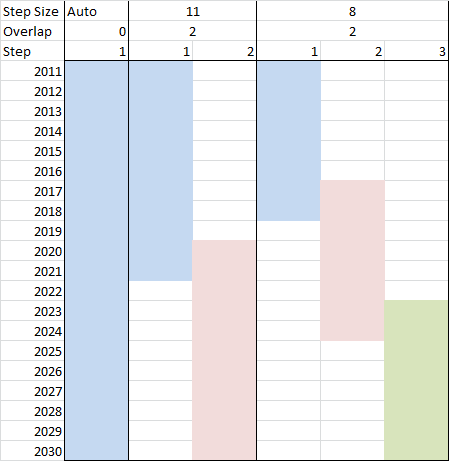LT Plan Overlap
| Units: | - |
| Default Value: | 0 |
| Validation Rule: | ≥-1 |
| Description: | Number of years overlap between steps where -1 invokes Rolling Horizon |
By default LT Plan solves the entire Horizon in a single optimization step, but there are two alternatives:
- Solve in multiple steps
- Solve using the rolling horizon method.
Solving in Multiple Steps
Multi-step simulation is invoked with the option Step Size > 0. Overlap can then be any non-negative number.
The advantage of solving in steps is that the resolution of each step can be greater i.e. the number of time periods solved. The disadvantage is that the overall optimality of the solution is compromised due to the lack of 'look-ahead'. To improve on this, the LT Plan Overlap sets the number of years each step of LT Plan overlaps with the next, the default being no overlap. The duration of each step is controlled by the Step Size setting.
The following formula shows the number of steps calculation for a given horizon, step size and overlap, with the overlap and step size combination being valid if it returns an integer:
Number of Steps = (Horizon - Overlap) / (Step Size - Overlap)
Example
You are modelling a 20-year horizon starting in 2011. The table and Figure 1 shows the three possible combinations of At a Time and Overlap.
| Horizon | Step Size | Overlap | Steps |
|---|---|---|---|
| 20 | 20 (Auto) | 0 | 1 |
| 20 | 11 | 2 | 2 |
| 20 | 8 | 2 | 3 |
 Figure
1: Possible combinations of Step Size and Overlap for 20-year horizon.
Figure
1: Possible combinations of Step Size and Overlap for 20-year horizon.
Solving with Rolling Horizon
Rolling Horizon mode is invoked with Overlap = -1 and Step Size is > 1.
Rolling Horizon solves in multiple 'stages' progressively resolving the entire horizon to full detail. See the Step Size topic for more details.